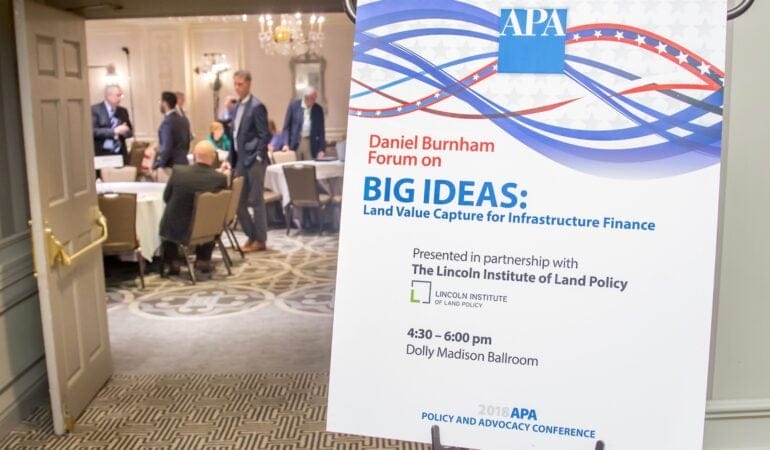
Value Capture
Land value capture—the concept behind several mechanisms to finance infrastructure, affordable housing, and other key components of urban development—was rich food for thought at the Daniel Burnham Forum on Big Ideas at the American Planning Association Policy Conference last month in Washington, DC.
As a policy approach currently being deployed around the world, land value capture enables communities to recover and reinvest land value increases that result from public investment and other government actions, such as rezoning. Also known as value sharing or value recovery, it is rooted in the notion that public action should generate public benefit.
The concept of land value capture has a long history, dating from the Roman Empire and including Baron von Haussmann’s 19th-century redevelopment of Paris, said Anthony Flint, senior fellow at the Lincoln Institute of Land Policy, who introduced an expert panel at the plenary session of the conference. The concept also traces its roots to the American political economist Henry George, who observed during the Gilded Age that private landowners were reaping the benefits of urban development and public investment through no effort of their own. George advocated for the land value tax—a more honest assessment of the way public actions boost the value of land—as a remedy.
Many well-known economic development and public finance tools in the United States are actually instruments of land value capture, even if they’re not labeled as such. These include, for example, density bonuses and inclusionary housing policies, which require developers of new residential projects to provide a portion of affordable homes (affordable housing was a major theme throughout the conference). Other land value capture tools include special assessments, developer exactions, betterment contributions, linkage fees, improvement districts, community benefit agreements, the transfer of development rights, and land assembly or land readjustment.
Cities around the globe have deployed other innovative land value capture mechanisms. In London, for example, the regional transit agency is helping to pay for its massive new CrossRail project by measuring and recovering increased adjacent property values resulting from the infrastructure. The city of São Paulo, Brazil, has raised billions of dollars by auctioning development rights on the stock market through an instrument known as CEPACs. Under Hong Kong’s “rail plus” model, the public transit agency partners with developers to build along rail lines and shares in the profits.
In the United States, land value capture is funding infrastructure at San Francisco’s Transbay Transit Center and New York’s Hudson Yards. New York Governor Andrew Cuomo proposed special assessment districts at new transit nodes, where developers and landowners benefit from the proximity of a station.

Julie Kim, program developer at Stanford University’s Global Projects Center, highlighted how land value capture can make local governments more fiscally independent. She said local governments must demonstrate how public projects increase value for the private sector in a direct and measurable way. She said reciprocal arrangements have come to be expected: if developers receive density bonuses, for example, they know they’ll need to provide more affordable housing in exchange.
Gerald Korngold, professor at New York Law School, contextualized the legal and constitutional framework of land value capture. He emphasized that while land value capture is not a widely used phrase in the United States, the policy tools are commonplace. “This is not some odd, newfangled idea,” he said. “It has been part of U.S. municipal finance for well over 150 years.”
Korngold said value capture policies need to be consistent with constitutional protections of property rights—specifically the Fifth Amendment stating that private property cannot be taken for public use without just compensation. Over time, landowners have challenged various regulations and requirements as a de facto “taking.” Korngold surveyed the history of U.S. property rights jurisprudence—from Justice Oliver Wendell Holmes’s caution in Pennsylvania Coal v. Mahon (1922) about government regulation that goes “too far” to Nollan v. California Coastal Commission (1987) and Dolan v. City of Tigard (1994), which established that exactions or contributions from landowners must have an “essential nexus” and “rough proportionality” between government demands and a project’s adverse impacts. In 2016, in of the most recent significant cases, the Supreme Court let stand an inclusionary housing ordinance in San Jose, which is not subject to the Nollan/Dolan test because it is designed to improve the public welfare, according to the California Supreme Court.
Michael Alexander, director of the Atlanta Regional Commission’s Center for Livable Communities, zeroed in on new partnerships and approaches to financing infrastructure and urban redevelopment in the Atlanta area. Local governments in Georgia use financing tools such as tax allocation districts (TADs) and community investment districts (CIDs). CIDs, which are self-taxing districts blended with public-private development finance strategies, have financed projects such as the new streetcar extensions in the Atlanta metro region.
The panelists agreed that the goals of financing infrastructure and more equitable urban development were paramount—especially in the absence of a national plan for urban infrastructure. There is no substitute for government funding and borrowing, but land value capture can be a critical supplement.
This article was also published by the American Planning Association.
Photographs: Pixelme Studio
